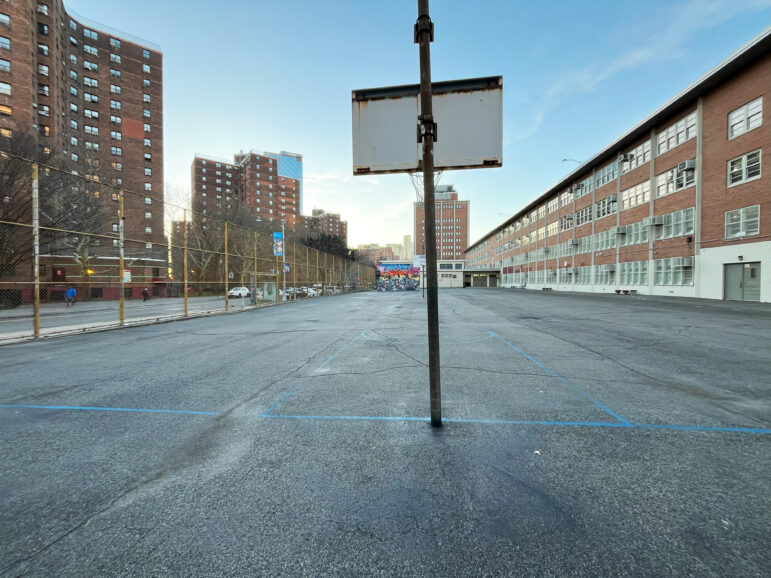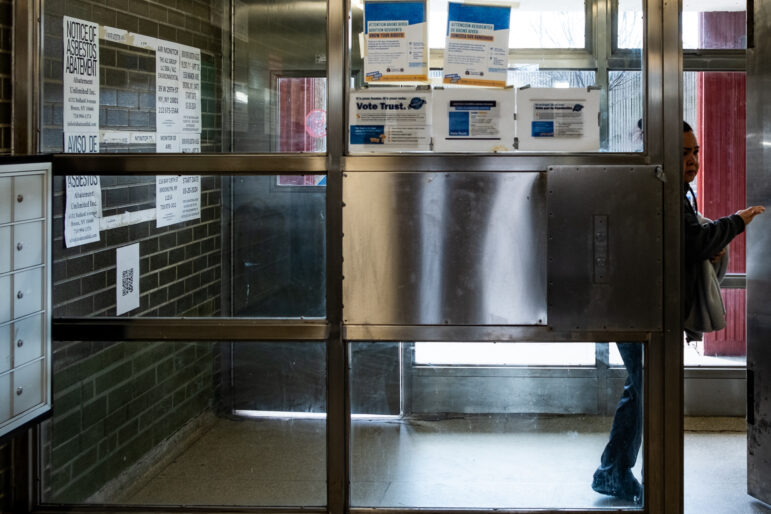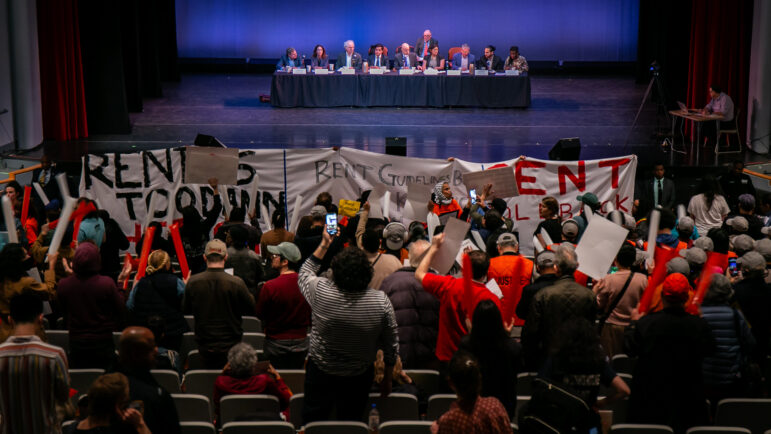
Megan Moskop was visiting a classroom in the Bronx in early January when the teacher reminded some restless students to focus during the last 15 minutes before lunch. Standard directions for students feeling antsy before the mid-day meal.
Except it was 9:25 a.m.
“Coming back as a visitor, I thought, “What? This is absurd,” says Moskop, a former public school teacher who works as an adjunct special education professor for the City University of New York. “People say, ‘That happens at all schools. That’s the reality.’ But the system created this reality.”
Get the best of City Limits news in your inbox.
Select any of our free weekly newsletters and stay informed on the latest policy-focused, independent news.
That Bronx school’s early morning lunch period isn’t unique. Throughout the city, public schools stretch the concept of “lunch,” sending students to the cafeteria as early as 9 a.m. The extremely early lunches trouble staff, parents and advocates and seem to disproportionately occur at schools in low-income communities.
“I don’t like that. To me that’s breakfast time,” says Shaun Francois, vice president of District 37 Council, the municipal employee labor union that represents school lunch staff. “What do you eat for the rest of the day? Your brain needs nutrients.”
Extreme lunch times persist
In 2014, the Daily News and WNYC reported that more than 56 percent of schools began serving lunch before 11 a.m. The report, visualized by WNYC’s SchoolBook.org , was the last time that school lunchtime data was widely shared.
At the time, 75 schools began serving lunch between 9 a.m. and 10 a.m., including 16 schools that started serving before 9:30 a.m. Those extremely early lunches continue, City Limits found .
The Department of Education did not provide a list of school lunchtimes to City Limits, but individual school data is available through the Office of Food and Nutrition Services website. The data shows that lunch service starts before 10 a.m. at 41 of those 75 schools five years later. Three have closed and 21 others serve lunch between 10 a.m. and 11 a.m.
Susan E. Wagner High School in Staten Island serves lunch at 8:58 a.m. six minutes before its 2014 lunchtime, according to OFNS. The school had 3,284 students last year, according to the DOE’s 2017-2018 School Quality Guide.
Robert A. Van Wyck Junior High School in Queens serves lunch at 9 a.m., compared to 9:57 a.m. in 2014. The school had 1630 students last year, according to the DOE’s 2017-2018 School Quality Guide.
Most of the 16 schools that began serving before 9:30 a.m. in 2014 have pushed lunch a few minutes later. A handful have been able to serve lunch closer to mid-day.
The High School of Applied Communication in Long Island City now serves lunch at 10:44 a.m. and the Academy for Language and Technology in the Bronx serves lunch at 11 a.m.
Principals play the biggest role in choosing school lunch times, but their hands are tied at buildings with multiple schools but only one cafeteria and school lunch staff. The situation leads to bargaining and compromise, with principals swapping vacant classrooms or prime gym periods for a better lunch time, Moskop says.
“It’s a terrible use of any educator’s time to make deals about who has enough space or enough food or enough time,” she says.
Jamaica High School, which served lunch at 9:06 a.m. in 2014, closed at the end of that school year. Today, four different schools, including the High School for Community Leadership (HSCL), operate in the building.
Digest the Data: Click here for a chart of
how lunch times have and haven’t improved
since 2014.
In 2014, HSCL served lunch at 9:06 a.m., but the school now serves lunch from 12:15 a.m. to 12:45 p.m.
“[Early lunches are] not the particular case for my school, which shares the Jamaica Campus with three other schools, but it is very common and a terrible problem,” said HSCL Principal Carlos Borrero. “In our case … we are extremely lucky.”
The Department of Education says that most of the schools that started serving lunch before 9:30 a.m. in 2014 — 12 of which start lunch service before 10 a.m. the current school year — have large student bodies that require numerous lunch periods. Lunch times also depend on school start time, DOE says.
Tottenville High School, for example, had 3,808 students last year, according to the DOE’s 2017-2018 School Quality Guides. It has two cafeterias, one larger than the other and five lunch periods, the first beginning at 9:37 a.m. and the last ending at 1:33 p.m.
School starts at 7:13 a.m. and students have the same lunch period every day, school staff say.
The DOE says the the director of operations at each Borough Office advises principals that lunch should begin no earlier than fourth period when possible.
“Students shouldn’t eat lunch before 10 a.m., and driving down the number of schools serving lunch that early is a priority for the 2019-20 school year,” says DOE spokesperson Miranda Barbot. “We provide free, healthy breakfast and lunch for all students, and work with schools serving an early lunch to offer students food later in the day. We’re taking a close look at how we can help schools identify more appropriate lunch periods that meet the needs of their community.”
DOE says it also provides snacks to students who participate in after-school programs, but Borrero says that gets complicated.
“It is hard to know beforehand what student will stay after school for something like tutoring yet we are required to give precise names and student ID numbers when requesting a snack be prepared prior to these activities,” he says. “In many cases the ‘accountability police’ are relentless. The bureaucracy for lunch services would make Kafka shutter.”
Disparities between districts
The early lunch times seem to affect students who attend schools in low-income communities more than those at high-performing schools in wealthier neighborhoods.
Take District 7 in the South Bronx and District 3, which includes much of Manhattan’s Upper West Side.
Only seven of 32 schools (21.8 percent) in District 3 start serving lunch before 11 a.m. All seven of those begin lunch after 10:45 a.m.
In Bronx District 7, which includes Mott Haven, Port Morris and Melrose, 24 out of 40 schools (60 percent) start serving lunch before 11 a.m.
“It’s dispossession, disinvestment and systemic neglect of schools with black and brown students,” Moskop says. “It’s such a glaring example of the way students’ health needs are totally being swept aside.”
DOE says the number of schools serving lunch before 10 a.m. in Bronx District 7 has declined from three in the 2013-2014 school year to one this year. The agency says it is working with District 7 schools to adjust scheduling. DOE also pointed out that no Manhattan District 3 schools served lunch before 10 a.m. in 2013-2014 or this school year.
Digest the Data: Click here for a chart of
how lunch times compare between
the Upper West Side and the South Bronx.
The USDA, which oversees the federal school meal programs, mandates that schools offer lunches between 10 a.m. and 2 p.m., but schools may request an exemption from the state.
“School meals are proven to support academic achievement and are a critical source of nutrition for food-insecure students who depend on free or reduced price school meals,” says Diane Pratt-Heavner, spokesperson for the Virginia-based School Nutrition Association. “Lunch period scheduling is an important part of ensuring students have equal access to school meals.”
The SNA advocates for longer lunch periods and to increase USDA funding for school breakfasts.
Pratt-Heavner says lunchtime is generally based on school population size — “overcrowded schools and those with small cafeterias are often forced to schedule multiple lunch periods to accommodate all students,” she says.
Lunchroom staff understand the impact of overcrowding on lunch periods and food waste, says District 37 Vice President Donald Nesbitt, a former school lunch staff worker.
“You have 2,000 kids and the lunchroom capacity is 300 kids,” he says, adding that students with early lunch shifts seem to eat less. “If you’re eating lunch at 9:30, you’re not hungry yet. There is waste.”
Extreme lunch times, missed opportunities
Early school start times often lead to early lunch times, resulting in hungry students, wasted food and missed opportunities for nutrition and socialization, says City Councilmember Mark Treyger, a former Brooklyn public school teacher who chairs the Council’s Committee on Education.
Treyger says he is unaware of a plan to address early lunch times or even a comprehensive data set to analyze.
School Food•Comptroller, Special Investigator and Private Firm Now Probing SchoolFood•An Ousted DOE Official, an ex-White House chef, an NBA star and a Pricey Breakfast Cereal
•City’s Milk Buying Could Help Farmers in Crisis and Workers in Need
•So Far, Push to Compost NYC School Food Waste is a Mixed Bag
“First, we need a lot more data than we have right now,” Treyger says. “And second, how do we challenge the system to build programming around the needs of kids?”
Treyger sponsored a council bill to study starting school later in the day. He says he would like every public school to open at 8:30 a.m. in order to give students more time to sleep so that they come to school healthier and better prepared.
The same concerns relate to school lunch times, he says.
“Why are we starting lunch at 9 in the morning just to check a box and denying the fullness of the opportunity,” Treyger says. “If students have school starting at 7:30 in the morning they might have a lunch period that is very early as well. How does the DOE intend to accommodate needs? The system is not being built around the needs of children.”
New Utrecht High School, where Treyger once taught, starts serving lunch at 9:04 a.m.
At James Madison High School in Sheepshead Bay, the first lunch period starts at 9:25 a.m., a problem for many students who eat at that time.
“It is way too early. People that have lunch periods at that time get hungry later on in the day which decreases our focus in classes,” says James Madison junior Matthew Merr, who has lunch from 10:42 a.m. to 11:28 a.m this year. “There is always at least one person at the end of the day that is hungry and wants to go home.”
Students who wish to change their lunch time have to rearrange their entire class schedules — something Merr says he had to do when the school mistakenly failed to schedule a lunch period for him.
“It was a pain because some classes are only at certain periods and to make up all the work for the new class is a pain,” he says. The last lunch period at James Madison ends at 1:58 p.m.
At Brooklyn Technical High School in Fort Greene, one of the city’s nine specialized high schools, the first lunch period begins at 10:22 a.m. The last ends at 2:48 p.m.
‘It’s not uncommon for kids to complain about being hungry,” says sophomore Hassan Mutazir. “I hear it multiple times a day.”
Hungry students can hit up a vending machine that dispenses unhealthy snacks during the day and they can go to nearby bodegas after the last bell, Mutazir says.
“There are also two or three delis near the school, so getting food after school is not an issue,” Mutazir says.
School nutrition advocates say that bodega bites and vending machine snacks are an issue, however.
“The link between food and learning is really strong and children need to eat whole, nutrient-dense foods for lunch,” says Andrea Strong, a journalist and founder of the parent-led advocacy group The NYC Healthy School Food Alliance. “It leads to obesity when kids leave school hungry. They go for what’s easy and think, ‘I need snacks, I need snacks.’ So they get a candy bar because it’s quick to fill you up.”
CityPlate , City Limits’ series on food policy, is supported by the Laurie M. Tisch Illumination Fund. City Limits is solely responsible for the content.









One thought on “Why do Some NYC School Kids Still Eat Lunch Before Some of Us Have had Breakfast?”
Pingback: It's 9:25am. How About Some Lunch? - This Is The Bronx